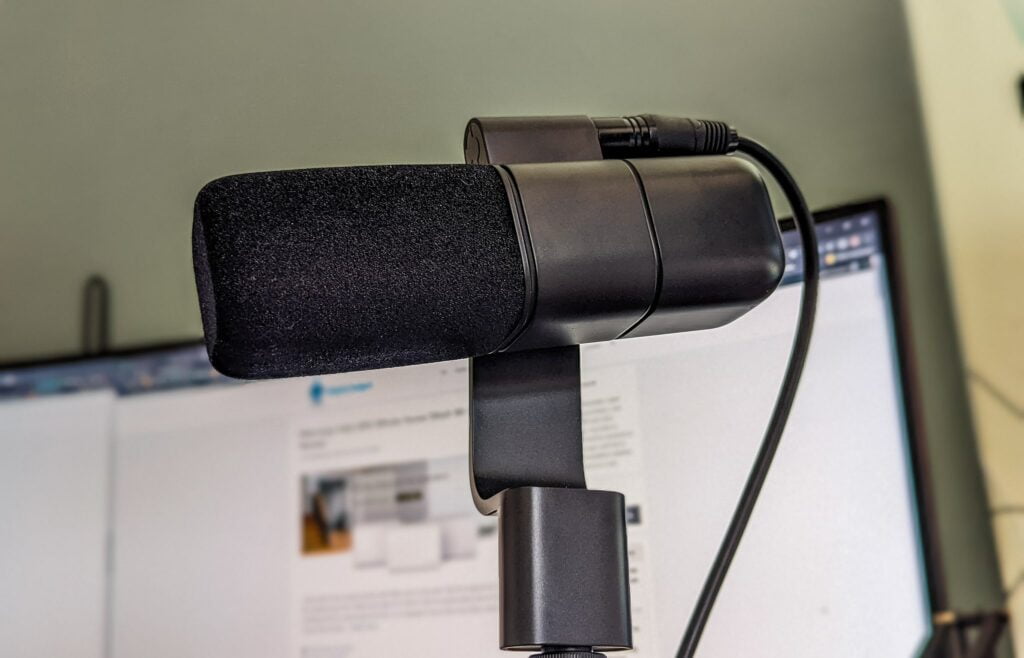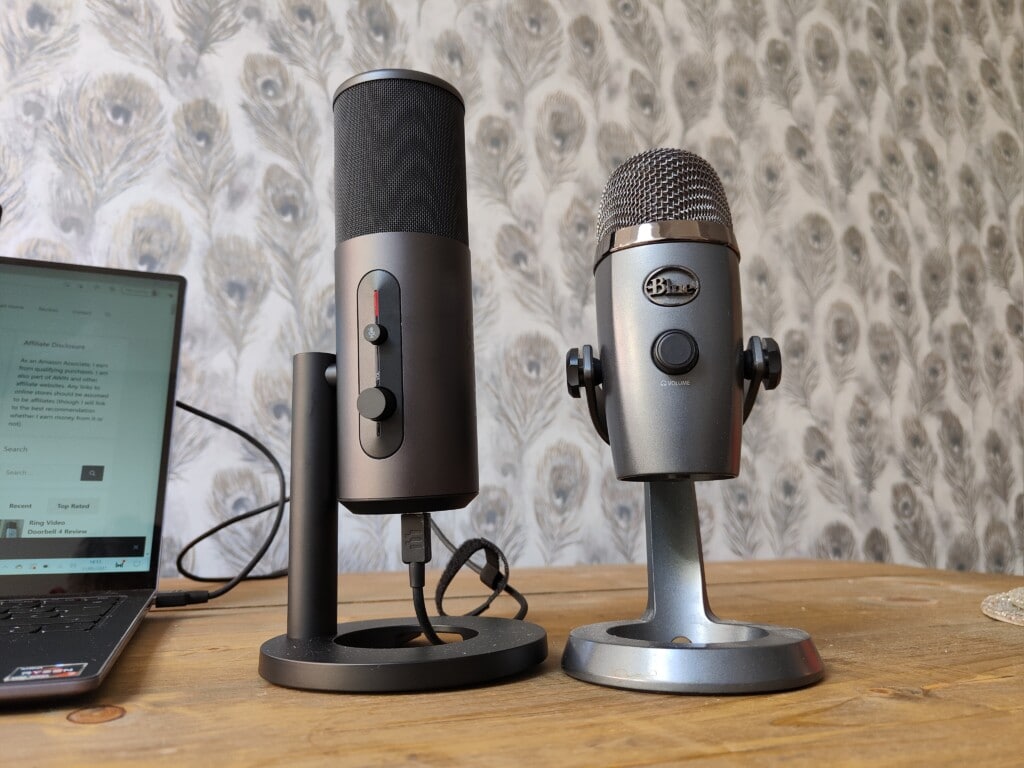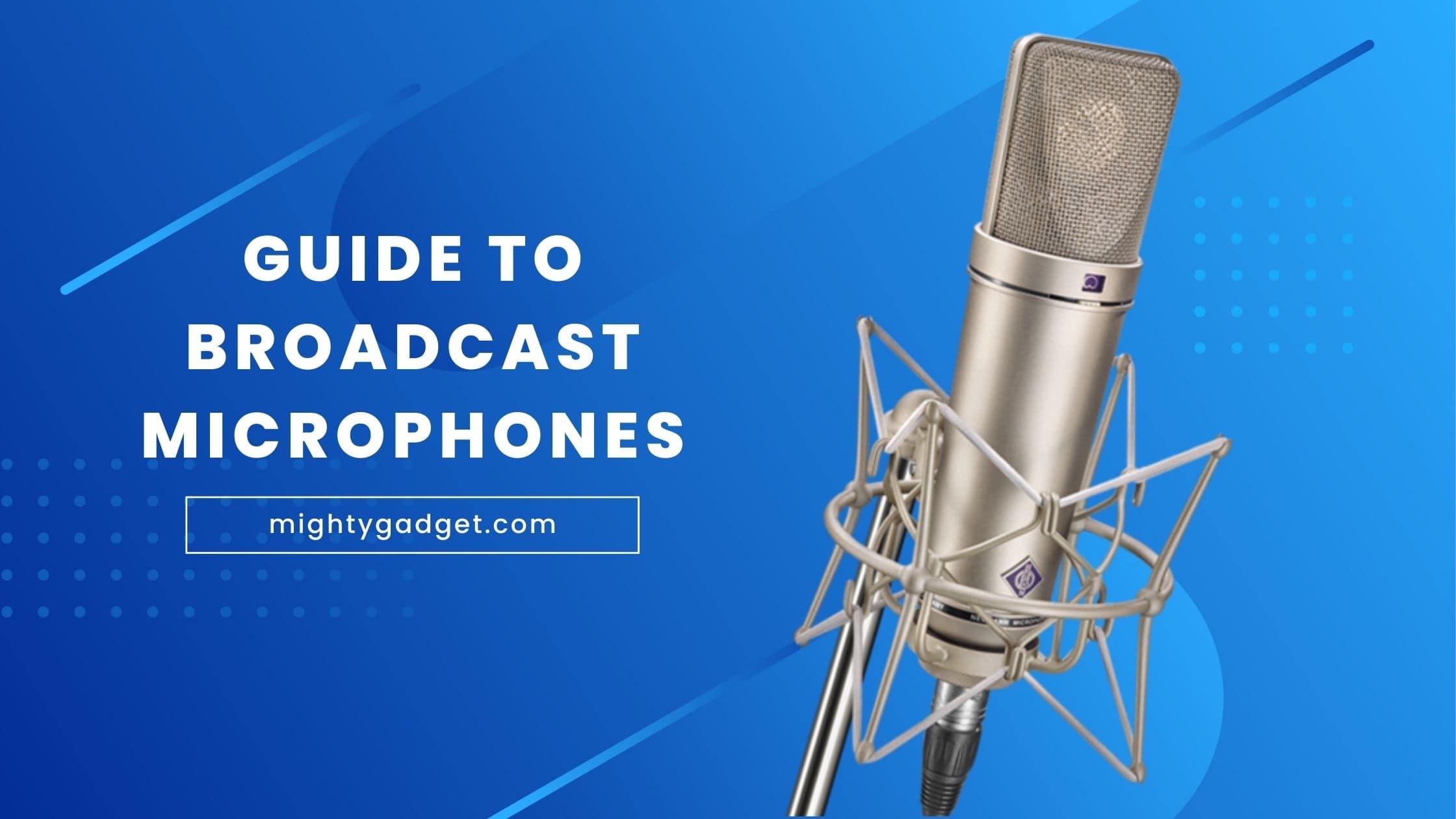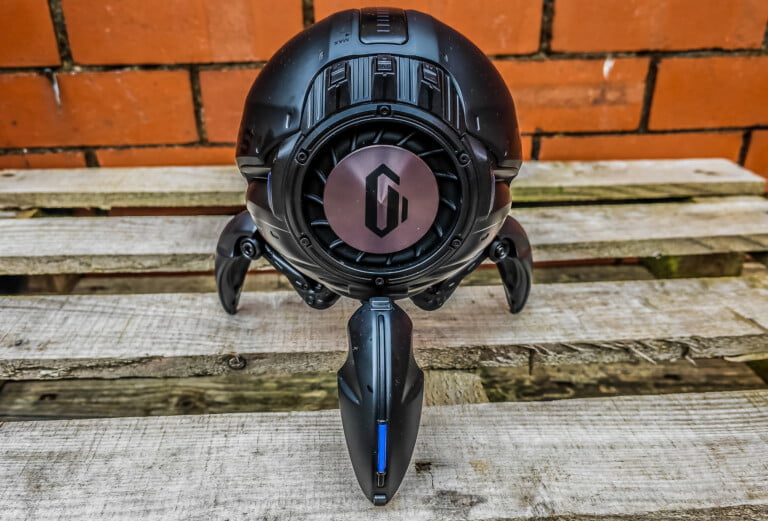Any links to online stores should be assumed to be affiliates. The company or PR agency provides all or most review samples. They have no control over my content, and I provide my honest opinion.
This article was originally published on Make the Sound Better. The structure of the article and some of the content remains the same, but I have added more details for some of the sub-sections.
A broadcast microphone, or a studio microphone, is a type of microphone specifically designed for use in broadcasting applications, such as radio and television broadcasting. These microphones are designed to capture high-quality audio with clarity and precision, ensuring that the audience clearly hears the voices of broadcasters, announcers, and performers.
Broadcast microphones typically have the following features:
- Directionality: They often employ a unidirectional or supercardioid pickup pattern, which means they primarily capture sound from one direction while minimizing background noise and unwanted sounds from other directions. This helps to isolate the sound source and improve clarity.
- Durability and build quality: Broadcast microphones are built to withstand the rigors of professional broadcasting environments. They are often made with robust materials and feature shock mounts to minimize handling noise.
- Frequency response: They have a balanced frequency response tailored to reproduce speech and vocals accurately. The frequency response may be optimized to emphasize the mid-range frequencies, where most speech intelligibility lies.
- Pop filters and windshields: Many broadcast microphones feature built-in pop filters or come with detachable windshields to reduce plosive sounds (such as “p” and “b” sounds) and minimize wind noise when used in outdoor or on-location broadcasts.
- Connectivity: Broadcast microphones often use XLR connectors, which are commonly used in professional audio setups. This allows for a reliable and balanced connection to audio interfaces, mixers, or broadcast consoles.
- Mounting options: They may come with various mounting options, such as desk stands, shock mounts, or boom arm mounts, to accommodate different broadcasting setups.
Dynamic vs. Condenser Microphones

Broadcast microphones can be classified into two main types: dynamic and condenser. Dynamic microphones are durable, affordable, and relatively resistant to background noise. They are ideal for capturing loud sounds such as music, live events, and sports commentary. Condenser microphones, on the other hand, are more sensitive and offer greater detail and clarity. They are well-suited for capturing speech, vocals, and subtle nuances in sound. However, they are more fragile and require phantom power to operate.
Here are the key differences between them:
- Principle of operation:
- Dynamic microphones: They use a moving coil magnetic diaphragm to convert sound waves into electrical signals. When sound hits the diaphragm, it moves within a magnetic field, generating an electrical current.
- Condenser microphones: They use a thin diaphragm placed close to a charged plate (backplate). Sound waves cause the diaphragm to vibrate, changing the distance between the diaphragm and the backplate, which results in a change in capacitance and generates an electrical signal.
- Sensitivity:
- Dynamic microphones: They are generally less sensitive than condenser microphones, meaning they require more sound pressure to produce the same level of electrical output. This can be advantageous in loud environments or when handling high sound pressure levels.
- Condenser microphones: They are more sensitive and can capture more subtle details and nuances in sound. They are often preferred for capturing vocals, acoustic instruments, and studio recordings where accuracy and precision are important.
- Power requirements:
- Dynamic microphones: They are generally passive and do not require external power. They can be directly connected to audio interfaces, mixers, or recording devices without the need for additional power sources.
- Condenser microphones: They require power to operate, usually in the form of phantom power (48V) supplied by an audio interface, mixer, or external power source. Some condenser microphones may also use batteries or have built-in power options.
- Frequency response:
- Dynamic microphones: They typically have a more limited frequency response compared to condenser microphones. However, this limitation can be advantageous in reducing background noise and handling noise.
- Condenser microphones: They generally offer a wider frequency response, capturing a broader range of frequencies, which makes them well-suited for capturing vocals and instruments with greater detail and accuracy.
- Durability:
- Dynamic microphones: They are often more rugged and durable, making them suitable for on-stage performances, outdoor use, and situations where durability is essential.
- Condenser microphones: They are more delicate and sensitive to handling noise, requiring careful handling and protection. They are commonly used in controlled studio environments where durability is less of a concern.
Polar Patterns and Directionality
Microphone polar patterns refer to the directional sensitivity of a microphone and describe how it picks up sound from different directions. Different polar patterns are suited to different recording situations. Here are some commonly encountered polar patterns:
- Omnidirectional:
- An omnidirectional microphone captures sound equally from all directions.
- It has a 360-degree pickup pattern, making it ideal for capturing ambient sound, group vocals, or situations where you want to capture a natural, room-like sound.
- Cardioid:
- A cardioid microphone is most sensitive to sound coming from the front and rejects sound from the rear.
- Its pickup pattern resembles a heart shape, hence the name “cardioid.”
- It is commonly used for solo vocals, podcasting, and situations where you want to focus on a sound source while minimizing background noise.
- Supercardioid/Hypercardioid:
- These polar patterns are narrower and more directional than the cardioid pattern.
- They have a tighter pickup pattern that captures sound primarily from the front and rejects sound from the sides and rear.
- They are useful in situations where you need to isolate a sound source while still allowing some degree of off-axis pickup, such as in live performances or stage environments.
- Bidirectional (Figure-8):
- A bidirectional microphone captures sound from the front and rear but rejects sound from the sides.
- It has a pickup pattern that resembles the number 8, hence the name “figure-8.”
- It is often used in scenarios where you want to capture sound from two sources, such as interviews, duets, or capturing sound from both sides of a microphone in a studio setup.
- Shotgun (Highly directional):
- A shotgun microphone is highly directional and has an extremely narrow pickup pattern.
- It captures sound primarily from the front and rejects sound from the sides and rear.
- It is commonly used in film and television production, field recording, or any situation where you need to capture sound from a distant source or isolate specific sounds in a noisy environment.
Sensitivity and Sound Pressure Level
Microphone sensitivity measures how well a microphone converts sound waves into electrical signals. The higher the sensitivity, the louder the microphone can capture sound. Sound Pressure Level (SPL) measures the maximum sound pressure a microphone can handle without distortion. Broadcast microphones typically have high SPL ratings to handle loud sounds without clipping or distortion.
Frequency Response and Equalization
Frequency response refers to the range of frequencies that a microphone can capture. Most broadcast microphones have a flat frequency response, which means they capture sound evenly across the frequency spectrum. However, some microphones may have a tailored frequency response that emphasizes or de-emphasizes certain frequencies. Equalization can be used to adjust the frequency response of a microphone to suit different recording environments and applications.
Proximity Effect and Bass Boost
Proximity effect refers to the increase in bass response when a microphone is placed close to the sound source. This effect can be used creatively to add warmth and depth to vocals and music. Some broadcast microphones have a built-in bass roll-off switch to reduce proximity effect and improve clarity. Other microphones have a bass boost switch to enhance low-frequency response.
Phantom Power and Battery Operation
Condenser microphones require phantom power to operate, which is usually supplied by the audio interface or mixing console.
Phantom power is a method of supplying power to certain types of microphones, typically condenser microphones, that require external power to operate. It is a DC (direct current) voltage that is applied to the microphone through the microphone cable. Here are some key points about phantom power:
- Power source: Phantom power is typically supplied by an audio interface, mixing console, or microphone preamplifier. It is commonly standardized at +48 volts (known as 48V phantom power), although some equipment may provide +12V or +24V phantom power as well.
- Condenser microphones: Phantom power is primarily used to power condenser microphones, which require a power source to polarize the microphone capsule and operate the internal electronics. Condenser microphones are known for their sensitivity and accuracy in capturing sound, making them popular in studio recordings, live performances, and broadcasting.
- XLR connection: Phantom power is typically delivered through the XLR connector on the microphone cable. The XLR cable has three pins: one carries the audio signal, one carries the ground, and one supplies the phantom power. The microphone and the audio device (interface, mixer, etc.) must both support phantom power for it to work.
- Balanced connection: Phantom power is transmitted over a balanced connection, which helps reject noise and interference. The balanced nature of the XLR cable ensures that the phantom power is delivered evenly to both the positive and negative signal lines.
- Compatibility: Not all microphones require phantom power. Dynamic microphones, for example, do not require external power and can operate without it. However, providing phantom power to a dynamic microphone does not cause any harm as long as the microphone is designed to handle it.
- Safety: Phantom power is generally safe for microphones that require it. However, it is essential to ensure that the microphone and associated equipment are compatible and correctly designed to handle phantom power. It’s recommended to consult the microphone’s documentation or manufacturer’s specifications to confirm its compatibility with phantom power.
XLR and USB Connections

Most broadcast microphones use XLR connectors, which provide a balanced signal and are widely compatible with audio equipment. USB microphones are another option, which can be directly connected to a computer or mobile device for recording and streaming. However, USB microphones may not offer the same level of audio quality and flexibility as XLR microphones.
Shock Mounts and Pop Filters
Shock mounts and pop filters are accessories that can improve the audio quality and reduce unwanted noise in broadcast recordings. A shock mount suspends the microphone in a cradle or elastic suspension system to isolate it from vibrations and handling noise. A pop filter, also known as a windscreen or foam cover, reduces popping and sibilance caused by air currents and breaths.
On-Air and Boom Microphone Stands
On-air and boom microphone stands are designed for different recording situations and environments. On-air stands are desktop stands that hold the microphone at a fixed height and angle, making them ideal for radio and podcasting. Boom stands, on the other hand, are adjustable stands that can be positioned at different angles and heights, making them ideal for television and film productions.
Broadcast vs. Podcast Microphones
Broadcast microphones are designed for professional use in radio and television, where audio quality and durability are paramount. Podcast microphones, on the other hand, are designed for amateur and hobbyist use in home studios and podcasting. While broadcast microphones may offer superior audio quality and features, they are also more expensive and may not be necessary for all podcasting applications.
Recommended Microphones for Various Applications
There are many broadcast microphones available on the market, each with its own features and specifications. Popular models of broadcast microphones include the Shure SM7B, Electro-Voice RE20, Sennheiser MD 421, and Neumann U87, among others
For podcasting, the Blue Yeti and Audio-Technica AT2020 are popular choices. When choosing a microphone, consider your recording environment, budget, and intended use to find the best option for your needs.
In conclusion, choosing the right broadcast microphone is a critical step in producing high-quality audio. By understanding the key features and specifications of microphones, you can make an informed decision that suits your needs and budget. Whether you are a professional broadcaster or a hobbyist podcaster, there is a microphone out there that can help you achieve your audio goals.
I am James, a UK-based tech enthusiast and the Editor and Owner of Mighty Gadget, which I’ve proudly run since 2007. Passionate about all things technology, my expertise spans from computers and networking to mobile, wearables, and smart home devices.
As a fitness fanatic who loves running and cycling, I also have a keen interest in fitness-related technology, and I take every opportunity to cover this niche on my blog. My diverse interests allow me to bring a unique perspective to tech blogging, merging lifestyle, fitness, and the latest tech trends.
In my academic pursuits, I earned a BSc in Information Systems Design from UCLAN, before advancing my learning with a Master’s Degree in Computing. This advanced study also included Cisco CCNA accreditation, further demonstrating my commitment to understanding and staying ahead of the technology curve.
I’m proud to share that Vuelio has consistently ranked Mighty Gadget as one of the top technology blogs in the UK. With my dedication to technology and drive to share my insights, I aim to continue providing my readers with engaging and informative content.







